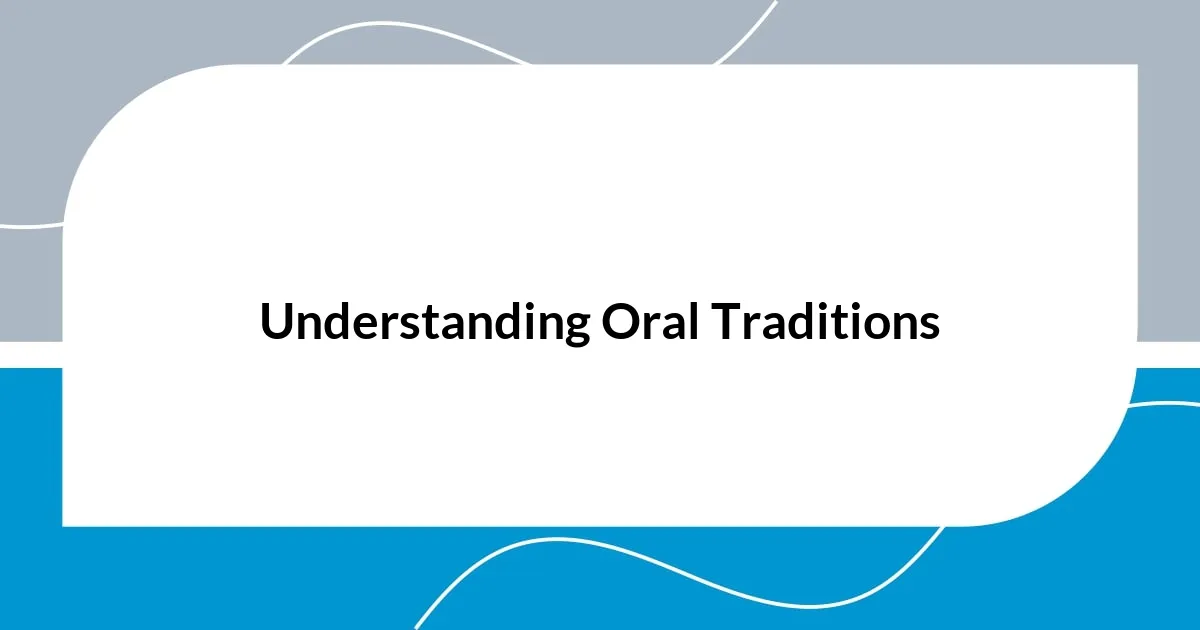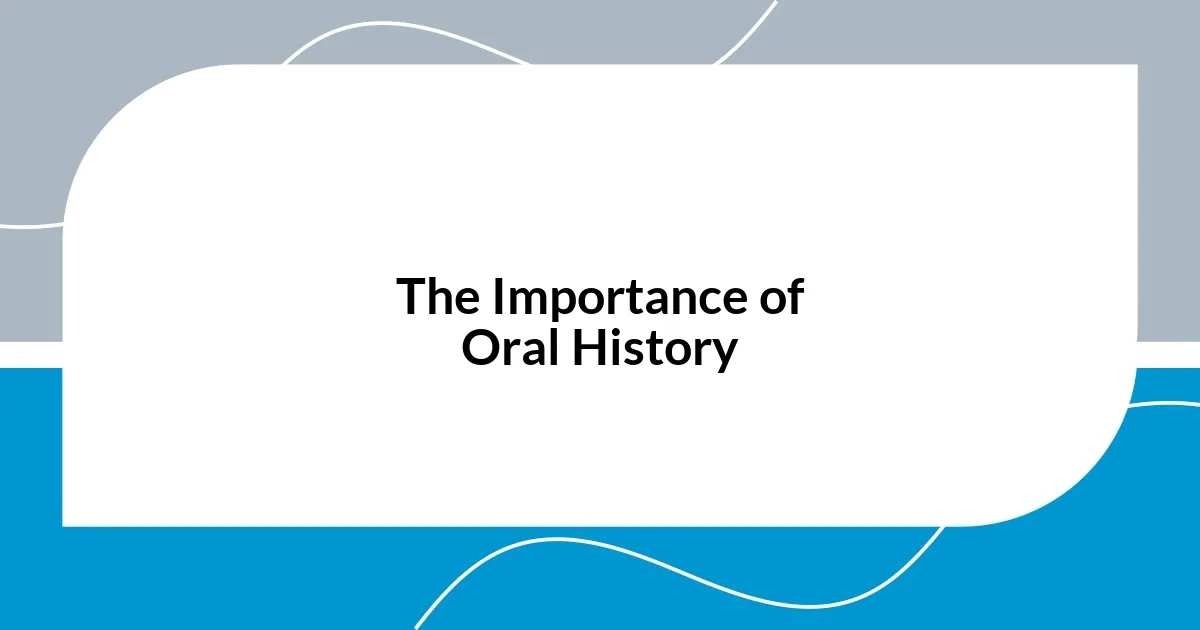Key takeaways:
- Oral traditions preserve cultural identity by connecting past and present, enriching community values and fostering deeper conversations.
- Oral history humanizes events, creating a shared emotional experience that enhances understanding and belonging within communities.
- Local narratives reflect individual perspectives and moral lessons, anchoring stories in cultural context and communal participation.
- Documenting oral traditions through recording and transcription reveals layers of meaning, allowing for ongoing engagement with cultural heritage.

Understanding Oral Traditions
Oral traditions are essentially the lifeblood of cultures, encapsulating stories, beliefs, and practices handed down through generations. I remember sitting under the starlit sky with my grandmother as she recounted tales of our ancestors, her voice weaving a rich tapestry of history and emotion. Have you ever felt the weight of a story resting on your heart, knowing that it carries the essence of someone’s life?
Listening to these narratives, I realized that oral traditions do more than just entertain; they teach invaluable lessons about identity and community. Each story serves as a thread connecting the past with the present, allowing us to identify and reflect on who we are. When I share these tales with my friends, I see their eyes light up, striking a personal chord that often leads to deeper conversations about our shared values.
Moreover, oral traditions reflect the unique perspectives of each storyteller, often colored by their emotions and experiences. I’ve learned that every rendition of a story is a little different, and that’s what makes it so fascinating! Have you ever noticed how the same tale can resonate differently depending on who’s telling it? This fluidity not only preserves the past but enriches it, continuously breathing life into cultural heritage.

The Importance of Oral History
Oral history is a crucial vessel for transmitting cultural knowledge and memories, acting as a bridge between generations. I once attended a local gathering where elders shared stories of their struggles and triumphs, their voices rising and falling like the melody of a song. It struck me how these narratives not only document history but also foster a sense of belonging within the community.
One of the most powerful aspects of oral history is its ability to humanize events and experiences. I found this when I heard a tale of resilience from a neighbor who had faced significant challenges in their youth. As they spoke, the room fell silent, and I could feel everyone’s heartbeats synchronizing with the rhythm of their words. This shared emotional experience made the past vivid and relatable, enhancing our understanding of each other.
It’s also worth noting that oral history encourages active participation and dialogue. Many times, I’ve left gatherings filled with questions, eager to share my reflections and insights. For instance, after hearing a story of migration, I felt compelled to share my family’s journey, creating a rich tapestry of interconnected lives. This interaction not only preserves the past but also allows for the evolution of truths as we weave new stories into the fabric of our community.
| Aspect | Significance |
|---|---|
| Connection to Culture | Oral history links individuals to their cultural roots, fostering identity. |
| Emotional Engagement | Personal narratives resonate, bringing history to life and creating empathy. |
| Community Bonding | Sharing experiences cultivates connections, enhancing the sense of community. |
| Dynamic Evolution | Oral traditions evolve over time, allowing stories to adapt and remain relevant. |

Key Elements of Local Narratives
Local narratives are a fascinating blend of history, emotion, and cultural identity. Each story I’ve encountered often reflects the unique circumstances and perspectives of the storyteller. I remember a time when a local fisherman shared tales of his father navigating stormy seas, a narrative filled with both pride and loss. It was in those moments that I grasped how local narratives embody the struggles and victories of their communities, giving life to historical events that textbooks often overlook.
Key elements that define the essence of local narratives include:
- Cultural Context: Stories are anchored in the specific cultural practices and beliefs of the community.
- Personal Experience: Individual perspectives and emotions enrich the story’s impact, making it more relatable to listeners.
- Moral Lessons: Many narratives aim to impart wisdom or illustrate the values that define the community.
- Symbolism and Imagery: Vivid descriptions and metaphors are used to evoke emotions and paint a picture in the listener’s mind.
- Community Engagement: These narratives often involve communal participation, fostering bonds among listeners by sharing collective memories and experiences.
When I think about how local narratives weave our community together, I remember an afternoon at a storytelling festival where young and old alike shared their tales. I was struck by how each story, no matter how seemingly simple, resonated deeply, linking our experiences and emotions in a shared journey of understanding. The laughter, the tears—it all created a beautiful tapestry of connection that highlight Google’s search results often miss when studying cultures merely as facts and figures. Each narrative is a thread that holds us together, reminding us of our interconnectedness.

Methods to Document Oral Traditions
Documenting oral traditions requires a thoughtful approach that respects the nuances of storytelling. One effective method I’ve employed involves audio recording sessions, which truly captures the richness of a voice as it tells a story. I recall sitting with a local elder, the microphone nestled between us as he recounted tales of our ancestors. Hearing his laughter and pauses felt like experiencing the narrative firsthand, as if I was transported to the moments he described.
Transcribing these recorded stories is another crucial method. This often leads to surprising discoveries, as I meticulously typed out the elder’s words. In one instance, I stumbled upon a hidden metaphor that perfectly illustrated the struggles of his generation, and I thought to myself, how many layers does each story really hold? The written transcript allows for analysis, enabling future generations to engage with the stories on multiple levels, unraveling meanings over time.
In addition to recording and transcribing, I find that participatory storytelling events are invaluable. At a community gathering, I noticed how people lit up as they shared their experiences, sparking connections I hadn’t anticipated. Watching someone build upon another’s story made me realize how oral traditions are often collaborative rather than solitary. This interplay not only enriches the narratives but deepens our shared understanding of identity and place. Isn’t it fascinating how each person’s voice contributes to the narrative landscape, melding individual experiences into a collective memory?

Learning from Community Storytellers
Learning from community storytellers is a transformative experience for anyone willing to listen. I vividly recall a night at my local library’s storytelling circle, where an elder shared stories from her childhood during a time of upheaval. As she spoke, I felt the room shift; the emotions in her voice painted pictures of resilience and hope that textbooks could never convey. It’s in these intimate moments that I realized stories carry not just words, but an entire world of feeling and connection.
What’s fascinating to me is how each storyteller brings a unique perspective to their narrative. During one session, a young boy shared his views on friendship through the lens of a beloved local legend. His innocent take sparked laughter and nostalgia among the adults, showing how storytelling bridges generations. I marveled at how his tale mirrored the timeless themes of loyalty and bravery, proving that the essence of our values can be beautifully distilled through the eyes of the young.
I often find myself pondering how these shared stories shape our identities within the community. When I listen, I don’t just hear narratives; I feel an intertwined history, rich with lessons about our humanity. After listening to a series of tales one evening at a community gathering, I left with a newfound appreciation for our shared experiences. It dawned on me—what if every story we shared could become a seed planted in someone else’s heart? Isn’t that the true power of storytelling?